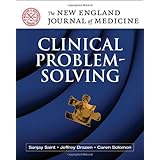
Average Reviews:

(More customer reviews)Great for anyone starting to think "clinically" or in a PBL (problem based learning) program
Click Here to see more reviews about: NEJM Clinical Problem Solving (New England Journal of Medicine)
Expert clinical problem-solving methods and guidance—from the editors and contributors of the New England Journal of MedicineThis invaluable resource from the New England Journal of Medicine expertly addresses methods and challenges in clinical diagnosis. Including the peer-reviewed content of the NEJM's renowned "Clinical Problem Solving" feature, this powerful resource is packed with case discussions from both ambulatory and hospital practice. Each Case Presentation reveals thought-provoking clinical and laboratory clues as the diagnostic considerations begin to emerge. Subsequent clinical detail and discussion and expert analysis add to the diagnostic picture until a final clinical diagnosis is reached. New England Journal of Medicine: Clinical Problem-Solving features:
Published cases drawn from the New England Journal of Medicine reflecting actual patient-management situations that physicians experience in their everyday clinical practice
Two brand new, never-before-published chapters on medical decision-making skills and methods
Wide-ranging coverage of the major considerations in each case, from underlying pathophysiology to signs from the physical examination to lab testing strategies
More than 100 full-color illustrations, tables, and algorithms
Meticulously selected references that open up avenues for further study
And much more!
From cover to cover, New England Journal of Medicine: Clinical Problem-Solving presents the best case analysis, diagnostic thought processes, and problem-solving-- direct from master clinicians. (20060901)

0 comments:
Post a Comment